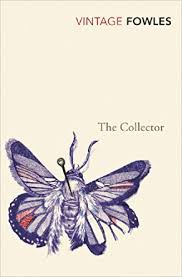The Collector by John Fowles, UK, 1963
 This novel is about a man called Frederick Clegg, who takes his butterfly-collecting hobby to the next level. Lonely, uneducated, and somewhat strange, Clegg becomes fascinated by a middle-class art student, Miranda, and as though she is some rare butterfly he decides he wants to collect her.
This novel is about a man called Frederick Clegg, who takes his butterfly-collecting hobby to the next level. Lonely, uneducated, and somewhat strange, Clegg becomes fascinated by a middle-class art student, Miranda, and as though she is some rare butterfly he decides he wants to collect her.
A large win on the pools gives Clegg the freedom to put his plan into action. He buys an old, isolated home in the country and then kidnaps Miranda, who we are told is unusually pretty, and places her in a room in the cellar. He is prepared to give her anything she wants except her freedom. He has no thought of forcing himself upon her sexually – he actually finds the idea quite atrocious – all he wants is to know that she is there in the cellar, that he can look at her whenever he wants, and that, eventually, she may learn to love him.
Of course, Miranda only wants her freedom, but she is sufficiently intelligent to realize that if she is to achieve her goal she must try to understand her captor. During this process the reader learns a lot about Miranda, who, like Clegg, has her own failings and misconceptions. Eventually, she reaches a point where she begins to feel sorry for Clegg, and she tries to make excuses for him.

Parallel to the main plot, and wound into Miranda’s observations of her present situation and her immediate past, is a discussion of the rising middle class, ‘. . . the new-class people with their cars and their money and their tellies and their stupid vulgarities and their stupid crawling imitation of the bourgeoisie.’ (Page 207). The novel manages to give some interesting perspectives regarding the many social changes in England of the 1960s, while, at the same time, it becomes obvious that in spite of Miranda looking down on Clegg as uneducated and ‘out of touch’ she herself is often both naive and unaware.
With an ending that is definitely disturbing, this is an interesting novel that can be appreciated on several levels.